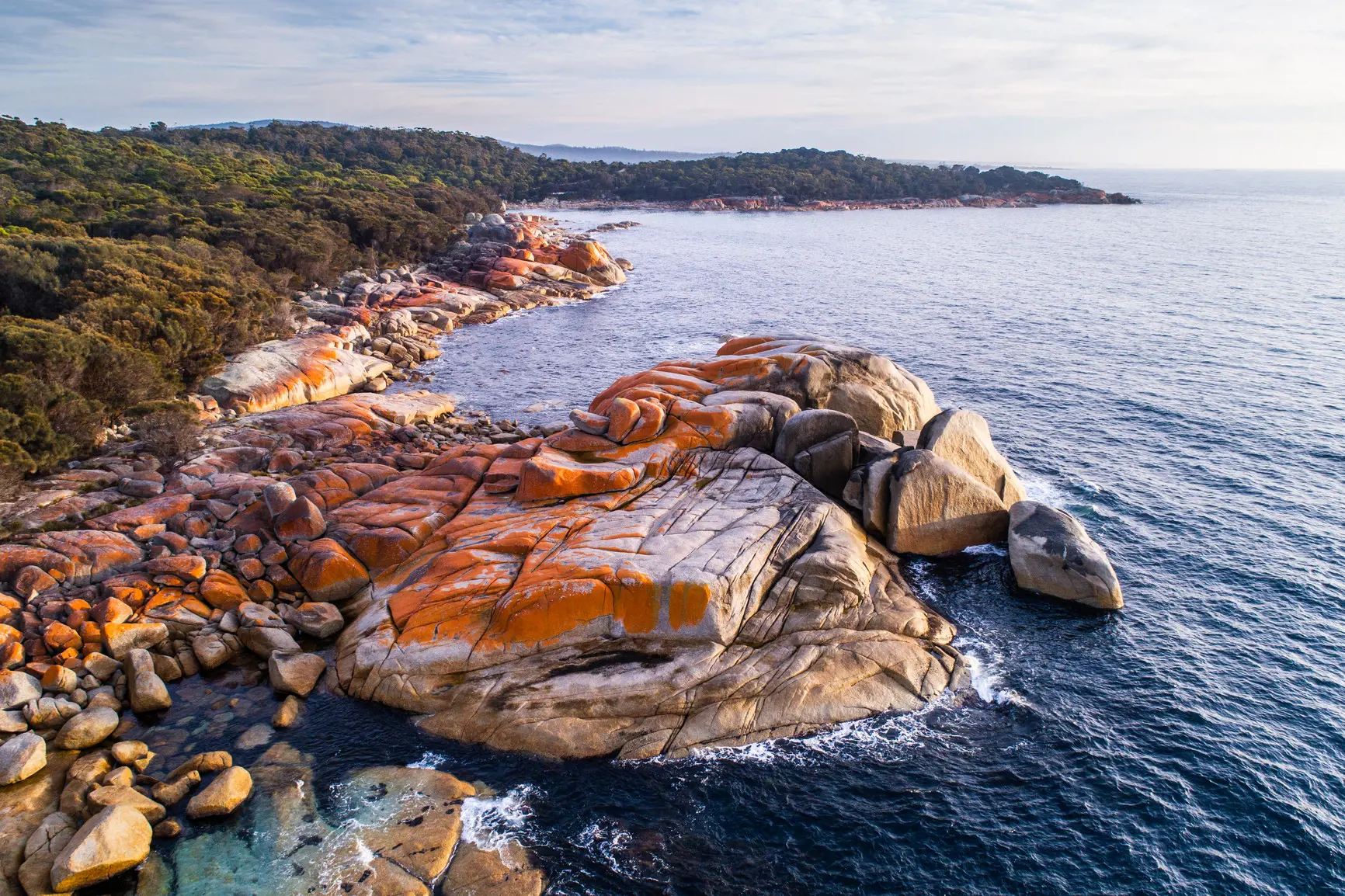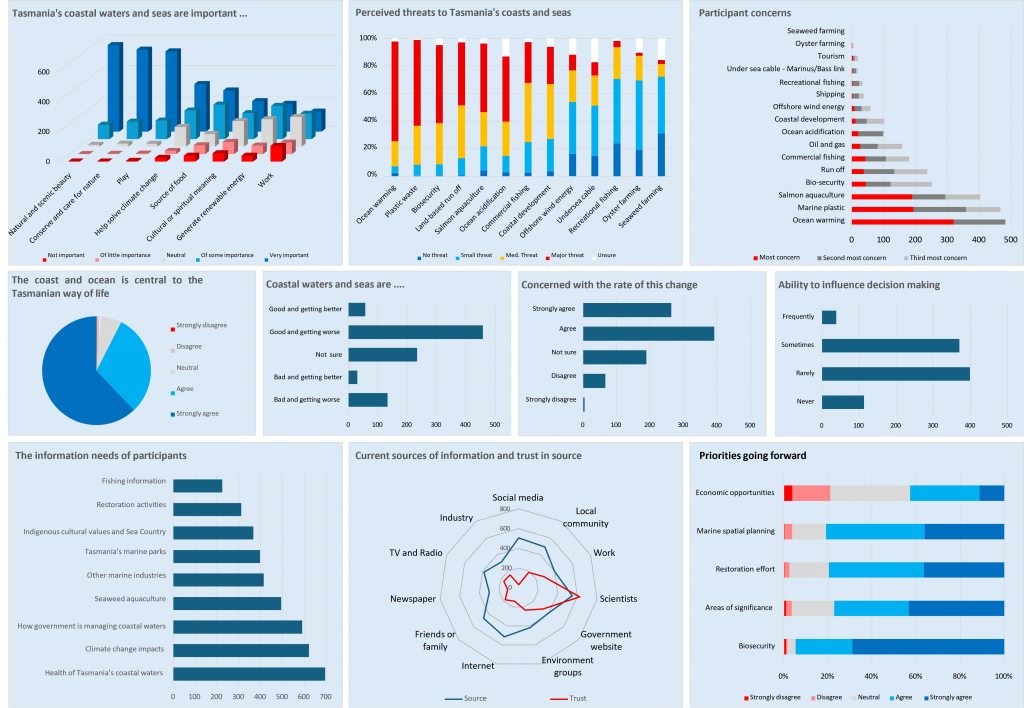Tasmania’s coastal waters and seas survey 2025 – CSIRO
- News item
- Publication

Summary of key findings
Tasmania’s coastal waters and seas are central to the Tasmanian way of life. Participants recognise their importance as a place of natural and scenic beauty (98%), a place to conserve and care for nature or for their environmental value (97%), and as a place to play or for their social value (96%). Tasmanian coastal waters and seas are also seen as a food source (74%) and as a place to help solve climate change (73%).
- Almost 70% of respondents were concerned not only about the health of Tasmania’s coastal waters and seas, but also the rate at which these environments were changing. They reported feeling worried or angry, and believed that they had minimal input and impact on government and industry decision making.
- Participants rated the top three threats to Tasmania’s marine environment as:
- Ocean warming and the increased incidence of marine heatwaves, storms, flooding, coastal erosion and habitat destruction;
- Plastic waste and its impact on marine life and the accumulation of microplastics in the food chain; and
- Biosecurity and the increased prevalence of disease, invasive species and harmful algal blooms (HABs).
Other significant threats were characterised by either:
- Large regional differences in perceptions, as for salmon aquaculture and run-off from industrial, urban or agricultural sources; or
- Lower levels of survey, as for ocean acidification.
Lower-level threats included seaweed and oyster farming, undersea electrical and data cables (Bass link and Marinus link), recreational fishing, and offshore wind energy.
- Participant concerns tended to be dominated by global risks such as climate impacts and marine plastic pollution. Salmon aquaculture was generally a secondary but widely acknowledged pressure point, that was characterised by localised industry-specific tensions. Lower priority concerns were biosecurity, agricultural and urban runoff, and commercial fishing. Concerns relating to recreational fishing, undersea cables, marine tourism and seaweed and oyster farming were consistently low (<8%).
- Marine literacy was important to all stakeholder groups with requests for information on waterway health, climate change impacts, and management planning a priority. Participants also requested information on stewardship activities, particularly restoration efforts. Survey respondents obtained information from a diverse range of sources, although they trusted few. A notable exception was marine scientists who are viewed as an important source of trusted information.
- In regard to priorities moving forward, participants recognised environmental stressors, and overwhelmingly supported additional allocations for biosecurity, restoration and marine spatial planning. They indicated that areas of significance (i.e., cultural significance, holiday locations, and recreational areas) should be respected as industries expand.
Sample size: 931 participants

Authors: Corrine Condie, Jess Melbourne-Thomas, Scott Spillias, Scott Condie
Contact: corrine.condie@csiro.au
Ethics: Approved by the CSIRO Social Science Human Research Ethics Committee (No. 207/24).
Funding: CSIRO Future Science Platform – Responsible Innovation
Date: 22nd September 2025
Project scope
This project is part of a broader CSIRO research program intensifying ‘What is responsible innovation?’. This project is focused on how different stakeholder groups perceive:
(i) the health of Tasmania’s coastal waters and seas;
(ii) the performance of marine based industries; and
(iii) how the marine-space should be planned and managed.
This survey is the first stage of a three-stage research project into ‘Low conflict pathways for Tasmania’s marine-based industries’.
Survey Methodology
- Sample
This was a Tasmania-wide self-administered paper-based stakeholder survey. The sampling method was a two-step mixed methods approach. 1000 questionnaires were distributed using a network approach (from 21 April to 21 June 2025), with a return rate of 93%. At the 99% confidence level this sample size has provided a confidence interval of 0.04, and a standard error of 0.01 (or the degree to which the results may vary from the true value). The high return rate likely reflects the intensity of interest provoked by both the relevance of the topic (the health of Tasmania’s coastal waters and seas), and protentional threats or impacts to the marine environment. - Key stakeholder groups targeted
Aquaculture industry: Salmon aquaculture, oyster farming, and seaweed farming.
Government/council: Commonwealth government, Tasmanian government, and local councils.
Marine scientists Private companies or at CSIRO: Environment (Hobart) and IMAS (University of Tasmania).
Tourist operators Those providing marine-tourism experiences.
Commercial fishers Commercial fishers that fish for scallop, scale fish, octopus or lobster.
Advocacy groups A broad section of the Tasmanian advocacy community including national and state-based
environmental and rightsholders organisations, and local groups including coast-care, bird conservation, and marine-based advocacy.
While the views of some Traditional Owners have been included in this group, there is no intention here to present the Indigenous voice on these issues.
Public groups:
Water enthusiasts: Those who use Tasmania’s coasts and oceans at least weekly to fish, surf, swim, dive, sail, paddle, or walk.
General public: Members of the public who were not allocated to Water Enthusiasts.
Disclaimer: CSIRO advises that the information contained in this publication comprises general statements based on scientific research. The reader is advised and needs to be aware that such information may be incomplete or unable to be used in any specific situation. No reliance or actions must therefore be made on that information without seeking prior expert professional, scientific and technical advice. To the extent permitted by law, CSIRO (including its employees and consultants) excludes all liability to any person for any consequences, including but not limited to all losses, damages, costs, expenses and any other compensation, arising directly or indirectly from using this publication (in part or in whole) and any information or material contained in it. CSIRO is committed to providing web accessible content wherever possible.
If you are having difficulties with accessing this summary document please contact csiroenquiries@csiro.au.
Contact us: 1300 363 400
+61 3 9545 2176
csiro.au/contact